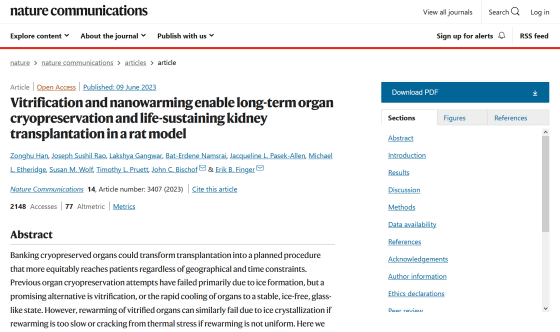Succeeded in animal experiments to thaw and transplant ``organs preserved for a long time at ultra-low temperature'', and the possibility of saving many lives if long-term preservation of organs for transplantation becomes possible

The obstacles in organ transplantation are not only the presence or absence of a donor, but also the ``time from removal of an organ from a donor to transplantation''. Therefore, even if a donor is found, the distance to the hospital where the patient is hospitalized is too far to be transplanted, or the organ of a donor who has expressed his intention to donate after death cannot be transplanted to anyone, and the organ is wasted. It is said that there are times when it ends. Although it was an animal experiment using mice, the world's first successful ``transplantation of organs preserved at ultra-low temperatures'' to solve these problems was reported in the academic journal Nature Communications.
Vitrification and nanowarming enable long-term organ cryopreservation and life-sustaining kidney transplantation in a rat model | Nature Communications

Researchers perform first successful transplant of functional cryopreserved rat kidney | University of Minnesota
https://twin-cities.umn.edu/news-events/first-successful-transplant-functional-cryopreserved-rat-kidney
Scientists successfully unfroze rat organs and transplanted them
https://www.statnews.com/2023/06/21/cryogenic-organ-preservation-transplants/
Many patients around the world are awaiting organ donation from donors, but the number of available organs is inadequate compared to the number of patients awaiting transplantation, and some remain unaided. There are many. It is not only the shortage of donors that hinders organ transplantation, but the `` organ supply chain '' is also a hurdle for transplantation.
Organs to be transplanted to patients are removed from donors who have died or been judged brain dead, but the organs after removal cannot be preserved forever. According to the Japan Organ Transplantation Network , the permissible time from organ removal to resumption of blood flow (ischemic permissible time) is 4 hours for the heart, 8 hours for the lungs, 12 hours for the liver and small intestine, and 24 hours for the pancreas and kidneys. So, organ transplantation can be said to be a race against time.
When transporting an organ removed from a donor to a hospital where a transplant operation is performed, traffic jams or unplanned delays can render the organ unusable. For this reason, aircraft and helicopters are sometimes used for transportation, but emergency air transportation of medical organs is dangerous, and the risk of death during organ transportation is said to be 1,000 times that of ordinary commercial flights (PDF). file) there is also an estimate .
In addition, the patient and the medical team may not be adequately prepared when the donor is confirmed dead and the transplant operation is rushed. Julie Kemink, a former nurse and chief operating officer (COO) of LifeSource, an American organ procurement organization, said, ``All transplant surgery is urgent.'' ``We feel that we are pressed for time. It's like planning a wedding in 48 hours.' About 20% of kidneys donated for transplantation cannot be used because they cannot be delivered to the patient in time.

One way to solve the problems related to organ transplantation is to freeze organs so that they can be preserved for a long time. There has long been a technique called '
Therefore, a research team at the University of Minnesota uses electromagnetic waves to activate the iron oxide nanoparticles contained in the cryoprotectant injected during vitrification, and uniformly thaws the entire vitrified organ. developed. By targeting the nanoparticles dispersed throughout the organ, it is possible to uniformly warm the entire organ, and it seems that the iron oxide nanoparticles used can be washed away after warming.
To test the effectiveness of this process, the research team conducted an experiment in which rat kidneys were cryopreserved in a vitrified state for 100 days, reheated in a nanowarming process, and transplanted to another rat. The kidneys transplanted to five rats gradually regained their function, although it took time, and the research team reported that the function was completely restored within 30 days.
Kidneys transplanted after thawing took 45 minutes to produce urine, which started in a few minutes when fresh kidneys were transplanted, and it was slow to remove creatinine , a waste product, for several days after surgery. 'The transplanted kidney was functioning, but not completely,' said study co-author Eric Finger, a surgeon at the University of Minnesota. Later it recovered, and after a month it was completely indistinguishable from a fresh organ transplant.'

This study was an animal experiment using rats only, and it was not measured how long the rats lived after surgery. It is also pointed out that healthy rats were used in this experiment, which does not match the real-life scenario where donors and patients have health problems.
In addition, there is a long way to go from animal experiments to clinical trials on humans. It is necessary to overcome various hurdles such as Still, the results of this study are very promising, and the research team plans to conduct animal experiments on pigs larger than rats in the next six months.
If it were possible to store organs removed from donors for a long period of time, patients living in remote areas would be given sufficient time to receive transplants, and they could not be transplanted due to time constraints. Organs can also be reduced. David Klassen, chief medical officer of Organ Sharing, a non-profit organization that contracts with the US government to oversee the domestic transplant system, said, ``The impact will be enormous.From the equation of organ transplantation If you remove time, things suddenly change dramatically.'

Related Posts:
in Science, Posted by log1h_ik







